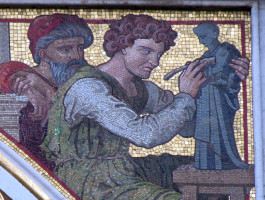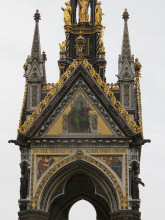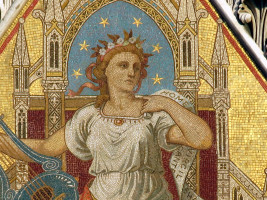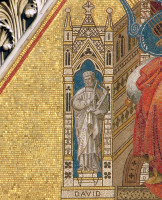 Detail of a sculptor at work, Albert Memorial mosaic.
Detail of a sculptor at work, Albert Memorial mosaic.
 Detail of a sculptor at work, Albert Memorial mosaic.
Detail of a sculptor at work, Albert Memorial mosaic.
The Albert Memorial contains one of the largest assemblages of Victorian mosaic in England. It is easy to merely glance at it, because there is just so much bejewelled decoration on the great structure that we may not pause on any one part, and because the mosaic work is so high up. This page looks in some detail at the mosaic decoration.
Each of the four sides contains a great triangular mosaic, each with a composition made of a seated allegorical girl, with the arms bearing depictions of small sculptures of standing historical figures. The background field is gold. Beneath each gable, two spandrels above a Gothic arch contain smaller mosaics, each of two figures. Above these is a line of text clear enough to be seen from the ground. Reading this all the way round, it says
‘Queen Victoria and her people// To the memory of Albert Prince Consort// As a tribute of their gratitude// For a life devoted to the public good’.
 Position of mosaics on Albert Memorial.
Position of mosaics on Albert Memorial.
Poesis (Poetry) is the front image, facing the Albert Hall. She wears a white drape, square cut at the neck, with short arms. Below, she wears an orange-red robe over her legs, turned over at the top to show the golden underside, and gracefully hanging down, with one foot exposed. She has a headpiece with blow flowers in her brown, curled hair, from which a flying ribbon depends to one side. Behind her head, as with all the figures, is a blue field with five golden stars. This forms the centrepiece of the back of the large throne each figure sits upon, with Gothic pinnacles and little windows. The sides of the throne, or little walls attached to it, come forward and outward to each side, each with at the front a niche with a standing figure, in monochrome as a sculpture, of an appropriate historical figure. For Poesis we have David [King David from the Old Testament, who wrote the Psalms], and Homer. Back to our central figure: she holds in one hand a stringed musical instrument, as in the ancient bards who strummed music with their poetic verses, and her other arm points back at herself in a melodramatic gesture. Around that arm, a hanging and twisted ribbon bears the names of Homer (again), Virgil, Dante, Shakespeare, Moliere, Milton and Goethe, a satisfyingly eclectic little pantheon of Western poets.
Now to the spandrel groups. On the left, a youth in a red tunic strums on a lyre, rather similar to that carried by Poesis, listened to by a second figure with head on hand in a relaxed position; we only see the upper part of this figure. Nice details on the stool and pillar adding to the air of Classicism. On the other side, a seated girl looks abstractedly to the side while leaning on her elbow and with quill pen poised above a parchment while she awaits inspiration; the half-seen young man with her rests his head on his clasped hands in an attitude of deep contemplation. The leafy branch of a tree is behind. (For a variety of sculptural allegorical figures of Poetry, see this page.)
Pictura (Painting) next. The allegorical figure wears a long, voluminous green gown, with many folds over the limbs and heaped up on the floor; the toes of one foot are however exposed, and the lines of her figure are emphasised rather than concealed by the fabric. In one hand she holds a palette and brushes, one of which just overlaps the thin red borderline around the edge of the mosaic; her other hand rests on the arm of her throne. The subsidiary figures show Apelles (a famous painter of Kos, in Greece, whose work does not survive but is referred to glowingly by Pliny the Elder among others) on our left, and Raphael on the right.
The spandrel beneath on our left has an artist, seated on a wooden stool covered with a sheet, painting on a large tablet held up by his female companion. The artist has in his other hand some sort of staff, and the picture, difficult to show in mosaic, is the initial outline of a pair of faces. The posing is most naturalistic, especially of the hand holding the brush, and the stockinged foot wound round the leg of the stool. The right hand group, of three figures, shows a half-standing mother with child, accompanied by a girl holding up a blue globe; a fence and trees are behind. Examples of allegorical sculpture of Painting is on this page.
Architectura (Architecture) is at the rear of the Albert Memorial (i.e. when considering the statue of Albert, he faces away from it). She is dressed in a red robe with a pattern of repeating circles with dots, perhaps representing the sun. Her hair, rather short, has a wreath of olive leaves in it, most elegant. Around her neck is tied a blue ribbon, and over her shoulders we see a white robe. She holds in her hands a tablet and compasses for measuring; the architectural plan shown on the tablet is, of course, the Albert Memorial itself. The subsidiary sculptures are of Solomon (builder of the Temple) and Ictinus, one of the builders of the Parthenon, most sublime temple of Ancient Greece.
Beneath on the spandrel to our left, two youths are at a table. One is measuring with a pair of compasses on a diagram; the other watches with sulky look, and holding a pen. His attitude shows boredom, resting on his elbow, with hunched back, and legs crossed. The companion spandrel shows two labourers building a wall, one assembling scaffolding, and the other mortaring the top of a Romanesque arch. (For allegorical sculptures of Architecture, see this page.)
Finally, and most symbolic for these pages, Sculptura (Sculpture), a most excellent young lady, somewhat more brawny in the arms than her sisters, I fancy, holding in one hand a small stantue of a kneeling girl, in the other her sculptor’s mallet. She wears a splendid blue robe, with bands of gold at the edges. The small statues are of Phidias, who made the statue of Zeus at Olympia, one of the Seven Wonders of the World, and Michael Angelo.
Beneath the spandrel on the left shows a single figure, a sculptor energetically chiselling at a statue of a seated girl with a bowl in her hands; a completed version is seen behind him. On the right, another sculptor is seen finishing off a standing female figure, advised by a bearded elder man standing behind him. Allegorical figures representing Sculpture may be seen see this page.)
The mosaics are by Salviati of Venice, briefly noted on this page. The glitter beautifully in the bright sunshine - this is why the pictures of Poesis are so bright compared to the others.
As works of mosaic art, they are, unsurprisingly, of the highest merit in composition and technique. Unlike so many mosaic works, and sculpture, they are appropriately sized for their height, so we can see most of the detail, without being lost in it. The spandrel figures are particularly good in this respect, with each scene clear, filling its space for balance, and using the medieval device of placing figures in seated or crouched position to maximise their size – if they stood up, they would be taller than the fields they occupy. The principal colours are those of the Renaissance painters – a bright red-orange, deep blue, a pinkish red, a mid green, and white, with gold background. But the actual number of colours is large, for highlights and shaded areas, and to show wood and fabric and skin. The combination of brightness and depth of colour and variety of subtle tints is characteristic of the Salviati mosaics, which are Smalti glass mosaics.
 Mosaic construction of face and upper torso.
Mosaic construction of face and upper torso.
Traditionally, such mosaic pieces are crammed closely together, with no grout between them, as this dulls the colours. The English use of Smalti in Victorian times, as practiced by Salviati and others, is to use a little grout for strength against the British climate, but the minimum possible, with the mosaic pieces cut to shape rather than leaving even the smallest area of grey grout other than the thin lines between pieces. The main lines of the figures are bordered with a special black Smalti mosaic, cut thinly, to make a thin black line along the principal edges; around the hands and face this changes to brown or russet colour. The laying of the mosaics on the face is along the contours, thus rounding the cheeks and making the breadth of the forehead, and showing the great muscle of the neck; on the body covered with clothing, rather than follow the shapes of the muscles, the lines of mosaic follow the main folds of the drapery, excepting some areas on the main allegorical figures, where for example the lines add to the roundness and fullness of the breasts. The backgrounds tend to be in straight horizontal lines o f mosaic, and following the Roman convention of a single line of mosaic outlining the foreground shapes. I am not aware of mosaic showing a higher degree of sheer technical virtuosity in England.
 Detail of one of the small figures (King David).
Detail of one of the small figures (King David).
Introduction to Victorian mosaics in London // A building in Liverpool with mosaics // Architecture page // Sculptors
Visits to this page from 13 Mar 2014: 11,330